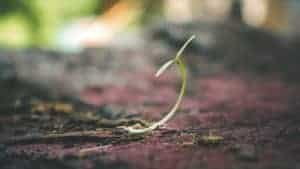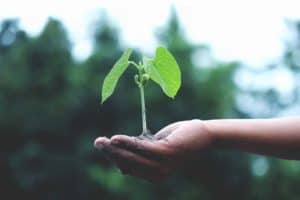Whether you’ve been buying plant starts at the nursery for years or you’re just getting started in gardening, you should consider growing your vegetables (and flowers!) from seed. If it seems daunting to you or that there’s a high risk of failure, it’s actually not difficult at all for most plants.
On this page:
Why You Should Start Growing From Seed
1. You have access to an enormous number of varieties you can’t find in the nursery or the supermarket.
Let’s say you want to grow a tomato. Did you know there are over 15,000 known varieties of tomatoes out there? The grocery store has anywhere from 2-5 varieties available, such a regular slicer, maybe a beefsteak, and some cherry tomatoes. The nursery might have a little more, but it’s still a small selection. There are tomatoes of all shapes and sizes, from ribbed beefsteaks to pear-shaped cherries to oxhearts (tomatoes shaped like an animal heart), ranging from colors such as red, pink, yellow, orange, purple, green, and even striped. And they all have their own flavor profiles you can explore as you grow them.
In some cases, your climate might be more beneficial for growing certain varieties that your nursery doesn’t sell. If you live in a dry, desert climate, you can find seeds of varieties that do well in those conditions. Sometimes you can find frost-hardy versions of the fruits and vegetables you love. You can also try growing ultra rare varieties of vegetables or flowers and participate in saving their seeds so they don’t go extinct.

2. Sometimes growing from seed is actually more beneficial for your plants than buying transplants from a nursery.
As I mentioned before, it’s not difficult to start most plants from seed. But in some cases growing from seed is actually preferable to transplanting. Many root crops, especially carrots and long radishes will often not develop a proper taproot if they are transplanted. You should never buy carrots from the nursery. At best, you will get a furry rootball or a thin, forked carrot. Beets and onions tend to be the main exceptions to this rule. Other vegetables like corn also tend to have problems with transplant shock and not grow as well as those sowed directly in the ground.
But what about tomatoes, peppers, eggplants, etc.? There is nothing wrong with using transplants, but always remember that in many nurseries, especially those in big box stores, they have to take care of hundreds or even thousands of plants, and might not take the extra care required for optimal growth. Meanwhile, if you start from seed, you’ll be taking care of your plants, potting them up
3. You can grow vegetables at different times of the year.
Let’s face it: most vegetable starts are sold in spring and early summer, and that’s about it. The thing is, you can plant vegetables at different times of the year and some do better when planted earlier or later.
For example, spinach is an early spring or fall crop, so by the time you’re buying spinach starts, it’s often already getting too warm for them. Same goes with lettuce. Even if you do get a few weeks or a month of good growth and harvests, once your leafy salad greens start to bolt (grow out a flower stalk) the leaves get bitter and it’s time to get rid of them. Then what? What if you want to replant them for a fall garden? Good luck finding them at the nursery. This brings me to my next point.
4. You can increase the yields of your garden tremendously with succession planting.
Say you did plant some lettuce and it bolted. What if you already had some lettuce seedlings ready to “deploy” and take their place? What if you harvested your garlic in July and now your garlic bed is empty until you plant your garlic again in October, so you decide to transplant some kale you already started and grow them for a few months? That’s called succession planting. It’s when you make efficient use of space and timing in your garden so there’s always something growing.
 A different type of succession planting is interplanting different vegetables with different growing habits and maturity to harvest at different times in the same space. For example, radishes take as little as 30 days to mature while beets can take 55 or more. What I like to do is direct sow my radishes, then when it looks like it’s a few weeks before harvesting, I transplant my beets between each row of radishes. By the time the radishes are ready to pick, the beets are just starting to crowd them out and maturing.
A different type of succession planting is interplanting different vegetables with different growing habits and maturity to harvest at different times in the same space. For example, radishes take as little as 30 days to mature while beets can take 55 or more. What I like to do is direct sow my radishes, then when it looks like it’s a few weeks before harvesting, I transplant my beets between each row of radishes. By the time the radishes are ready to pick, the beets are just starting to crowd them out and maturing.
Another easy example is planting onions in front of or sometimes between tomatoes. The onions have thin, long leaves and shallow roots, so they won’t crowd out the tomatoes as they’re growing.
This is something you will get more of a feel for with more experience in gardening, but it’s very easy to get started and definitely something you can’t do with nursery plant starts.
5. You can experiment with plant breeding and create your own varieties.
Sometimes crosses happen by accident if you grow vegetables close to each other, but you can also try to make your own. Is there a hot pepper that you’re growing that you wish had more of the sweetness of your bell pepper? You can cross them and create your own variety.
I’ve cross-pollinated a lot of peppers and a few tomatoes and it’s exciting to see what kind of weird combination of traits I end up with. Note that you will not notice a difference in the fruit after pollinating; pollinating a sweet bell pepper with a habanero won’t instantly create a spicy bell pepper. You have to save those seeds and plant them in order to grow out the cross with mixed traits.
Another important thing to know is that if you cross-pollinate them and save the seeds, you will technically have what’s called an F1 hybrid. If you want a stable variety that will grow out the same every year, you’ll have to save the seeds from that F1 hybrid and grow them (the F2 seeds) out for another generation and repeat the process for at least 6-8 generations before it becomes a stable variety. Then you can share them with friends and one day your variety might be considered an heirloom vegetable!
